- 5,122

- Panama City, FL
Carlos's woes about his Aprilia being down for a while put into my mind my own situation a couple of summers ago. This is a lo-o-o-o-ng story, so bear with me.
I went to downshift from third to second to make a turn at an intersection, but the shifter didn't move far enough and then wouldn't move at all, either up or down. I coasted over to the shoulder and got off, bent down to look at it, because looking always fixes it, right?
I try to push the bike and I find that it's in gear, as I can't push it without the clutch being pulled. With that in mind, I get on and start it back up, and ease out the clutch. The bike starts to move and then the transmission slips with the grinding noise of a missed shift. Back off the clutch a little and the slipping grinding goes away. I ease the clutch out ever so much more gently, and the bike will idle along.
So it's not quite in gear, but it's almost there, running in second. The downshift I attempted never completed, no clue why, but something in the shift mechanism is jammed hard.
This is just over 8 miles from home. I could call for a tow truck, but I'm flat broke, no cash on me, and all my plastic is at home. In hindsight it would have been much easier, but I'm stubborn and stupid.
I'm idling along and I reach the bridge over St. Andrews Bay here. One end of the bridge is Panama City, where I live, and the other end of the bridge is Panama City Beach, where I am. Bridges here at the coast are not flat pieces of highway stretched across a chasm of some kind, they are high arches that lift the road from ground level to an elevation high enough to clear things like ships and stuff that want to pass beneath it. That means the road now slopes up, and the not-quite-engaged second gear won't pull the bike up the hill.
So I start pushing. I pushed about 18 feet or so and began to search for other ideas. Bike is 650 pounds, and there's no way I can shove it all the way up the bridge's slope. Eventually I get an idea and try something. Turns out that with the motor running and me sort of pushing and guiding, walking along beside the bike, feathering the clutch, the gear will stay engaged strongly enough, without slipping, that the bike will pull itself up the slope. it just won't do it with me on it.
It takes about a half hour, but I make it to the top of the bridge. I shut it off and climb on, then refire and coast down the city side of the bridge. It's flat road all the way home from here, no more than a foot or two of elevation change for the whole duration. I ride on the shoulder of US 98 away from the bridge, and have plenty of room to stay out of traffic. I use 19th Street to get to Beck Avenue. 19th has a parking lane against the curb so it's plenty wide enough to continue to stay out of traffic. At Beck Avenue I turn left, and this road is narrower. There's a bicycle lane against the shoulder, and since I'm just about a bicycle now, that's how I finish the trip home, with emergency flashers blinking the whole time.
My driveway is sloped up to the house, so I have to repeat the walk-along-beside-it-slipping-the-clutch that got me up the bridge. It's now nearly two hours after the failed downshift.
That weekend I tear into the side of the bike, remove the clutch, then the clutch basket, and the problem is obvious:
That's the star cam, which is not supposed to be a separate piece! Looks like the weld broke, so that's what jammed up the shifter. Now what I don't know is what happened to break it off. Did something deeper down that hole get jammed, or broken? The bike's on the centerstand, so I grab that shaft of the shift drum with a pair of vice-grips, and push the rear wheel to turn the drivetrain, and I can move the shift drum down fully into second, then down into first, then I go back to second, then third. It seems there's nothing else actually wrong with it, so I run it back to neutral, which will make the next few tasks easier, because I want to put the clutch back in while I decide about repairing or swapping the engine. I don't want to have all those parts laying around and risk losing something, and once the clutch goes in, neutral makes life easier as I shove the bike around the garage.
Several weeks go by at this point with no work on the bike. A friend in central Florida has a complete engine, although its valves were destroyed by a cam chain tensioner failure. I can have the engine for free just for the effort of going down and getting it. I could put my cylinder head on it, stick it in the bike, and ride off happy. Another friend has a motor with no bottom end, as he spun a crankshaft bearing. Only known FJR bearing failure on our forum. He replaced his engine with a used one, as did the first guy with the busted-ass valves, so I have a choice of parts donors. The second engine was completely disassembled by his mechanic and all the parts bagged and stored, and free for the asking, just pay shipping. Hmmmm.....
So my choices are: 1. put my cylinder head on a free engine that's perfectly fine from the block down, and install that motor, or 2. tear down my motor and replace parts with donor parts from the bearing-failure motor.
I haven't made that decision, yet, and since my engine will either be replaced or repaired, I go ahead with the work of removing it from the bike.
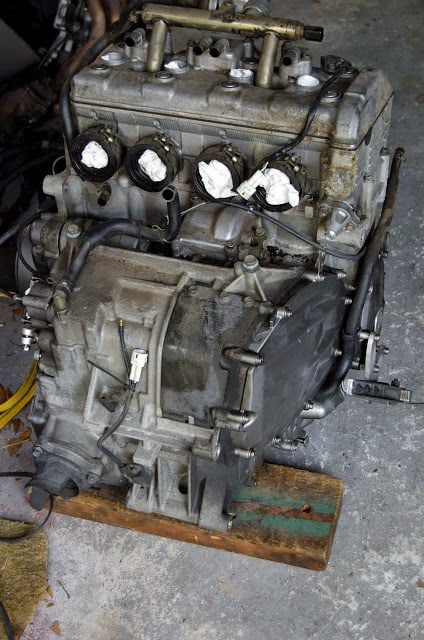

I make a little side trip here and do a valve check. It's entirely possible to do that with the motor in the frame, but while the motor's out, it'd be just stupid not to do it! Over 75,000 miles, and only one valve slightly tight, and it turns out I don't even need new shims; I can swap the shim with another valve that's borderline loose, and then they're both in spec! Done!

Buttoned up the valve cover, then I turned the motor over to start on the oil pan, and then the bottom of the crankcase.
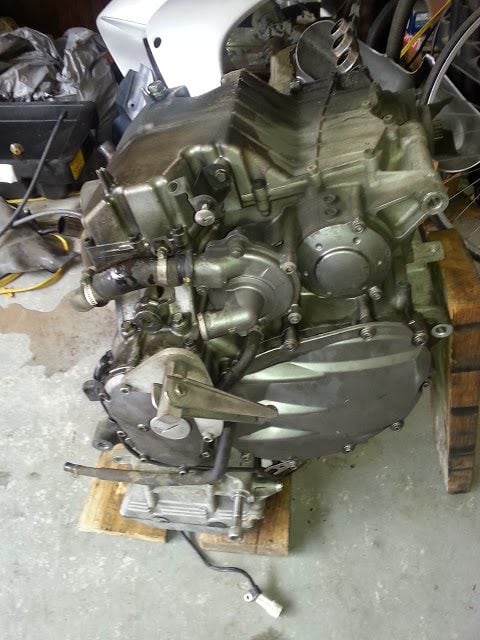
Oil pan off. Instead of putting the bolts in baggies, I put them back into the hole they came out of. Absolutely no confusion later about where they go! The big gear at the top is driven by the transmission's output shaft, and has the bevel gear for the drive shaft to the rear wheel. That's called the Middle Gear, I guess because it's in the middle, between the transmission and the drive shaft.
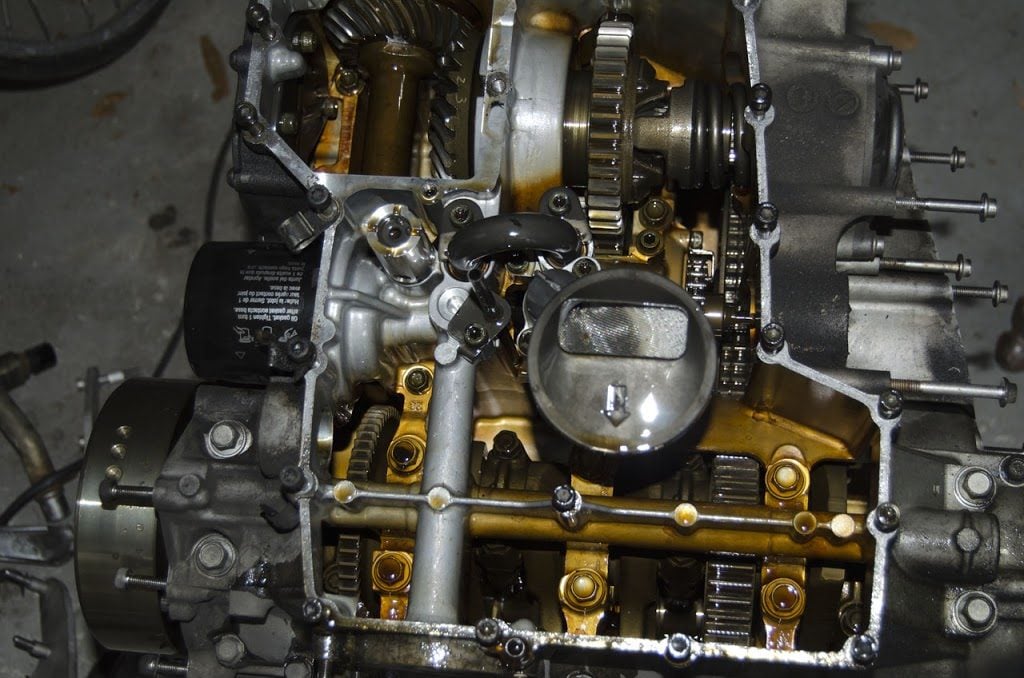
After removing all that oil pump stuff, I'm ready to split the case. The crankcase halves are bolted with 31 bolts, of which 10 are crankshaft bearing bolts, 17 are 10mm heads in four different lengths, and the other 4 are 12mm heads; two are shouldered and the other two are different lengths. This is why I stored the bolts in the holes they came out of!!!
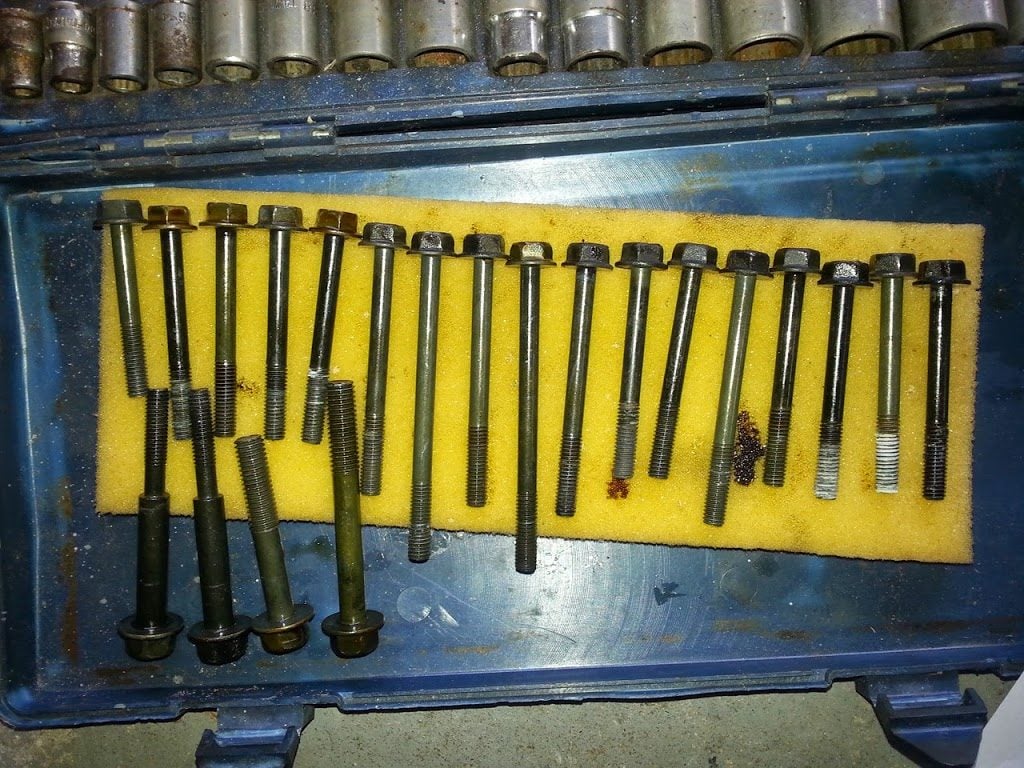
Those ten that serve as the crankshaft bearing bolts are single-use, so I had to replace those. They actually stretch when torqued to spec, to maintain a specific clamping force on the bearings, so they cannot be reused.
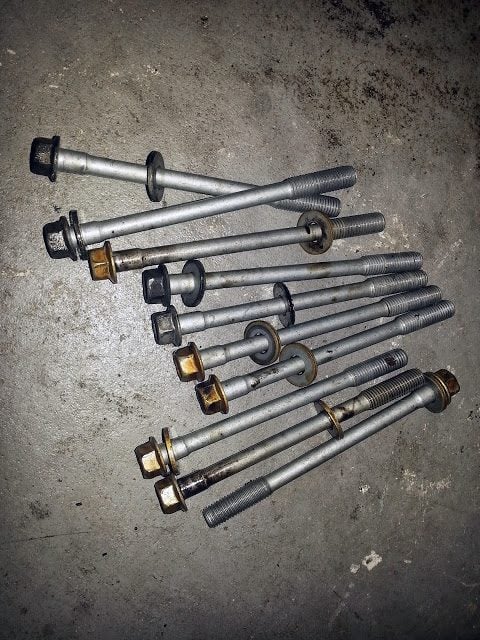
Crankshaft at the bottom of the pic, transmission output shaft in the middle. The input shaft is hidden underneath that. The driven shaft that goes to the bevel gear for the drive shaft has already been removed, as has the shift drum and shift forks..
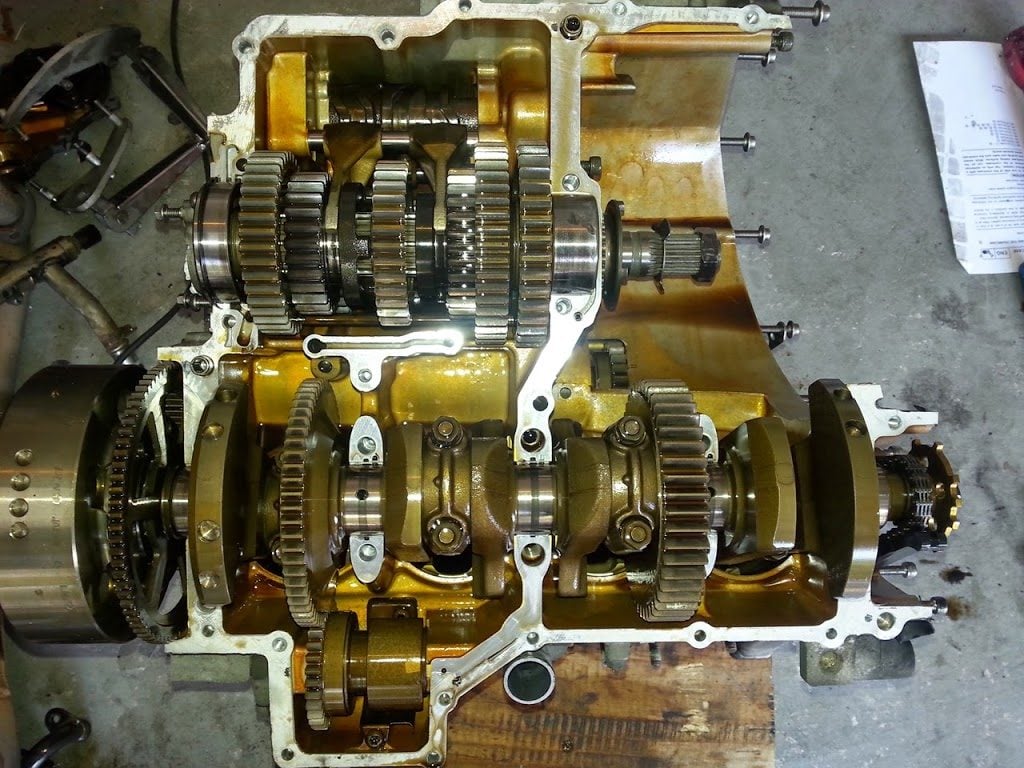
The output shaft just lifts out now, and the input shaft has a bearing housing that's bolted to the crankcase casting, then it slides out the side. Loose transmission: These things are way simpler than automotive gearboxes, which have synchronizer rings, helical gears, and thrust bearings. With straight-cut gears there are no side (axial) forces in the drivetrain, so no thrust bearings to adjust clearances on.
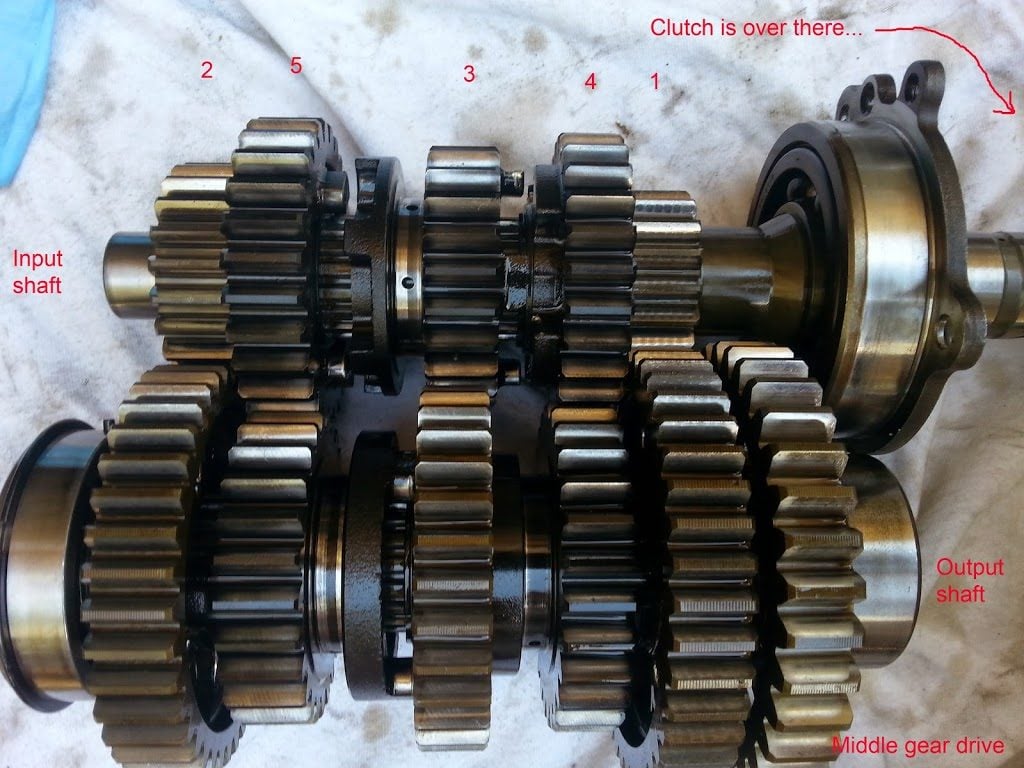
The reason I went ahead and pulled the transmission is that the 4th-gear shift fork looked like this when I got it out, and I wanted to see what was causing this severe wear. This is mine, next to what it's supposed to look like: Now you know why the oil pan drain bolt has a magnet on the tip.......
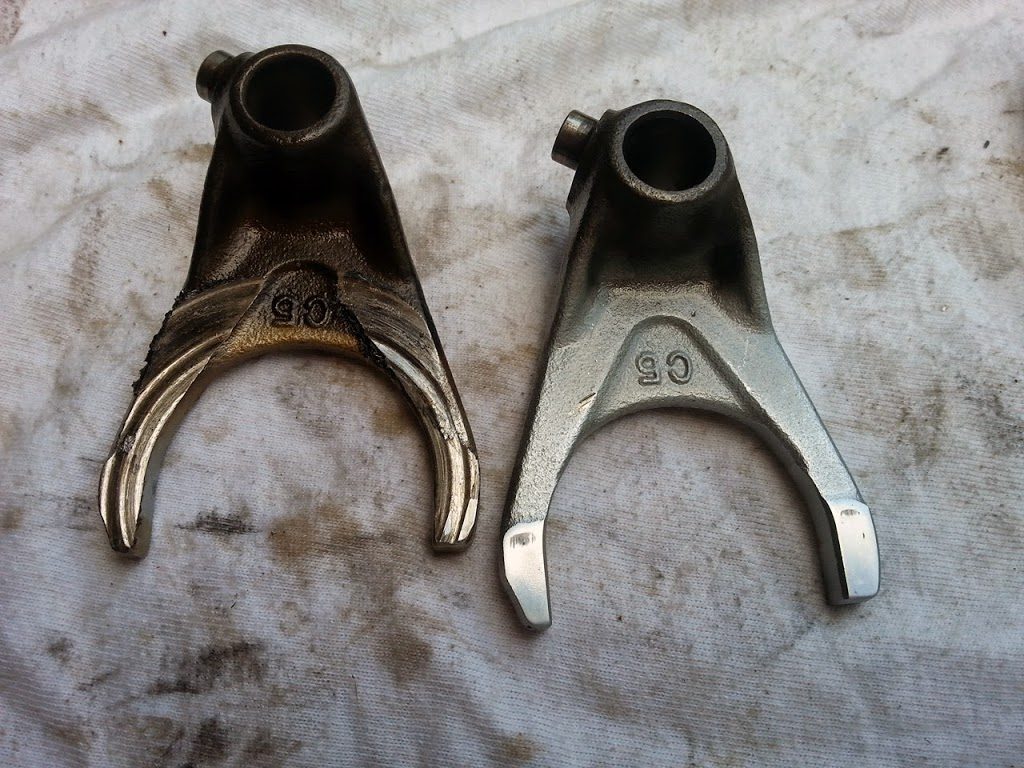
The is a shot of the dogs that engage 4th gear. The end of the pin has that angled area worn off. What that does is instead of engaging the mating surface flatly, it engages with the bevel, which pushes back against the other gear sideways, trying to force the gear to disengage. that sideways force is not supposed to exist with straight-cut gears, and that is what dug into the shift fork, effectively lathing it out over time.
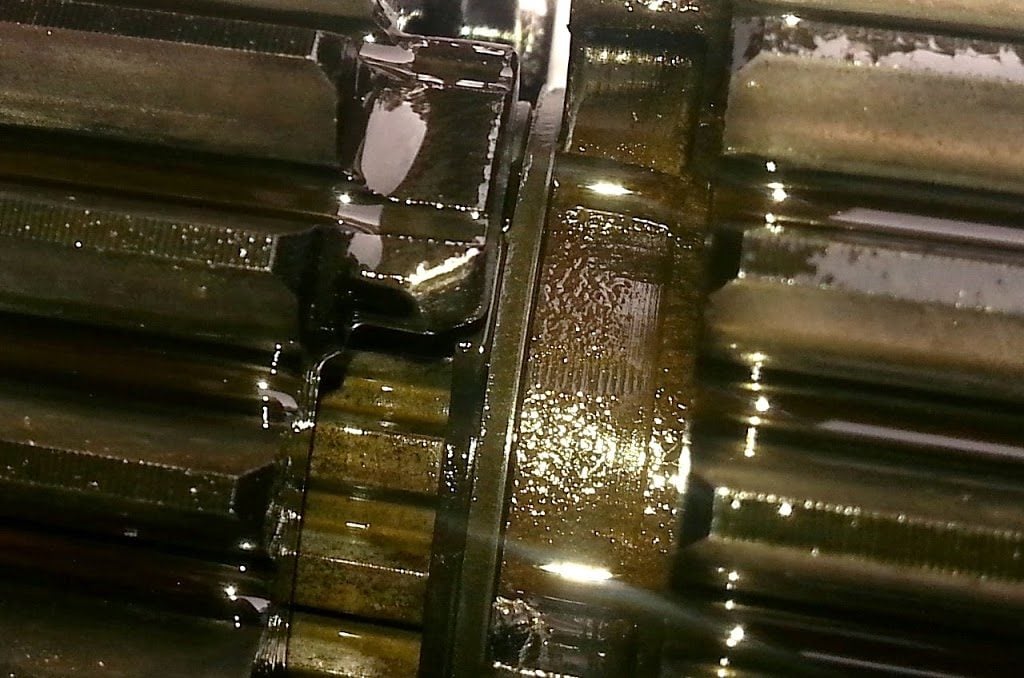
This is the mating surface that dog is supposed to engage. It's been hollowed out and no longer presents a flat face.
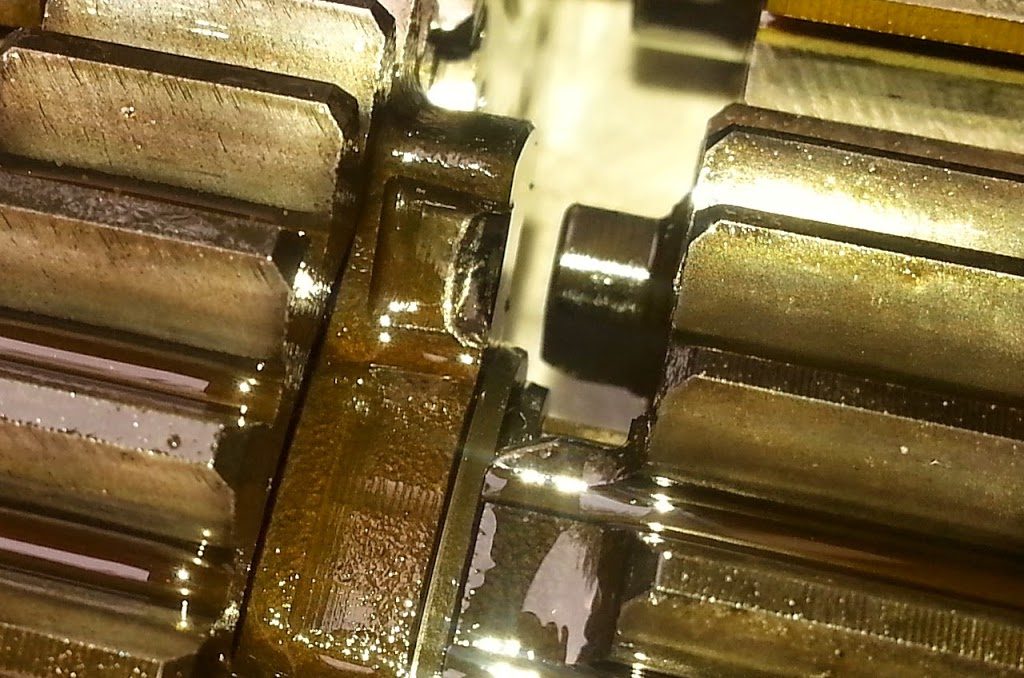
Here is the groove the 4th-gear shift fork rides in. The next picture is the same part from the donor motor, and it's clear how much steel is missing from my part!

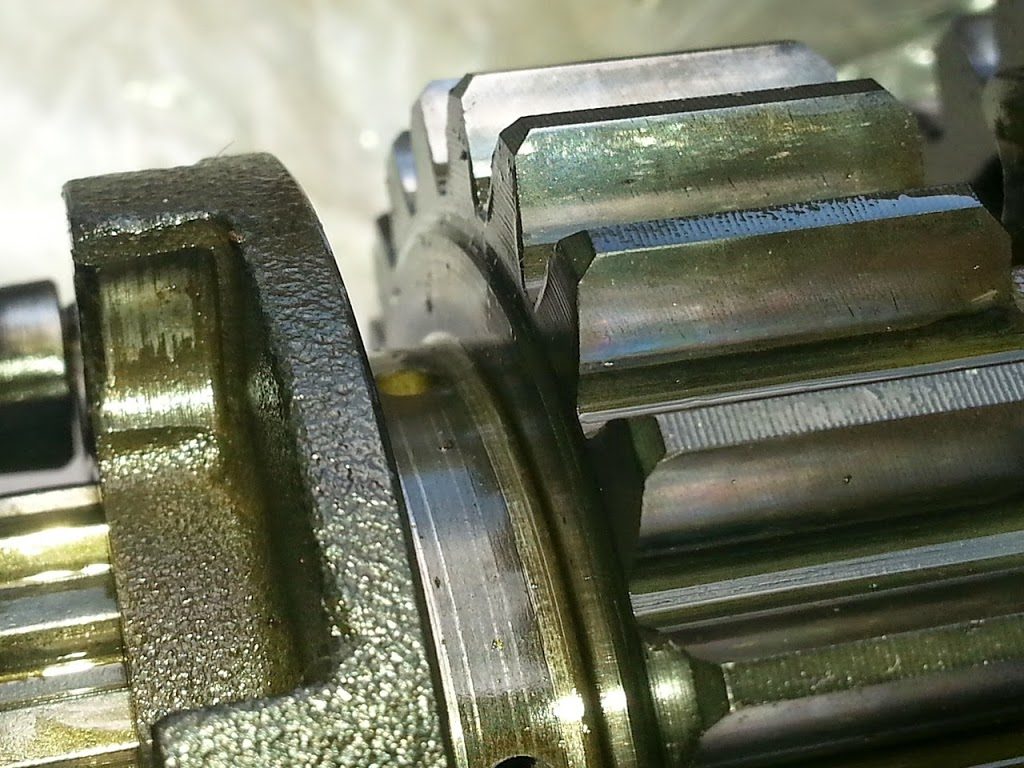
I sent an email to the guy storing the parts and told him that in addition to the shift drum from that motor, I'd be needing, well, both complete transmission shafts. And the shift forks, please and thank you.
I had to buy ten bolts (for the crankshaft bearings,) a 36mm socket (for the bevel gear on the end of the middle-gear shaft, and a tube of sealant for the case split surfaces (there's not a gasket there.) I also had to buy a torque angle gauge, and a small torque wrench that measures inch-ounces. All of the case bolts are torqued extremely lightly except for the ten over the crankshaft bearings.
I said earlier that the bolts that serve as bearing bolts for the crankshaft are single-use. You torque them to a certain spec, back them off and torque them again to that same setting, then add 120 degrees of rotation. That's what a torque angle gauge measures: how far you turn the bolt after setting the torque on it.
A couple of tools, some sealant, and the ten bolts are all I had to buy. The parts were free for asking, just paid the man the shipping. My total outlay was a bit over 120 dollars. By removing the front forks and rear wheel, and rocking the bike on the center stand, I was able to lift the frame off of the engine to remove the engine, then lower the frame over the engine to reinstall, and I was able to do that by myself. I couldn't lift the engine off of the floor once it was out, but I could rock it onto and off of Whatever is needed it to be sitting on, like a wood block or a wheeled crawler. Since I have no friends, figuring out how to get the thing out and back in by myself was rather useful!
By the way, I do have the actual factory service manual for the bike, so no guesswork was involved at any step of this process. I had sequences, torque specs, parts lists, everything I needed except a couple of tools before I ever started. 117 days from breaking it to riding it again. The actual work was spread over 4 or 5 weekends mostly at the end of that time.
I went to downshift from third to second to make a turn at an intersection, but the shifter didn't move far enough and then wouldn't move at all, either up or down. I coasted over to the shoulder and got off, bent down to look at it, because looking always fixes it, right?

I try to push the bike and I find that it's in gear, as I can't push it without the clutch being pulled. With that in mind, I get on and start it back up, and ease out the clutch. The bike starts to move and then the transmission slips with the grinding noise of a missed shift. Back off the clutch a little and the slipping grinding goes away. I ease the clutch out ever so much more gently, and the bike will idle along.
So it's not quite in gear, but it's almost there, running in second. The downshift I attempted never completed, no clue why, but something in the shift mechanism is jammed hard.
This is just over 8 miles from home. I could call for a tow truck, but I'm flat broke, no cash on me, and all my plastic is at home. In hindsight it would have been much easier, but I'm stubborn and stupid.
I'm idling along and I reach the bridge over St. Andrews Bay here. One end of the bridge is Panama City, where I live, and the other end of the bridge is Panama City Beach, where I am. Bridges here at the coast are not flat pieces of highway stretched across a chasm of some kind, they are high arches that lift the road from ground level to an elevation high enough to clear things like ships and stuff that want to pass beneath it. That means the road now slopes up, and the not-quite-engaged second gear won't pull the bike up the hill.
So I start pushing. I pushed about 18 feet or so and began to search for other ideas. Bike is 650 pounds, and there's no way I can shove it all the way up the bridge's slope. Eventually I get an idea and try something. Turns out that with the motor running and me sort of pushing and guiding, walking along beside the bike, feathering the clutch, the gear will stay engaged strongly enough, without slipping, that the bike will pull itself up the slope. it just won't do it with me on it.
It takes about a half hour, but I make it to the top of the bridge. I shut it off and climb on, then refire and coast down the city side of the bridge. It's flat road all the way home from here, no more than a foot or two of elevation change for the whole duration. I ride on the shoulder of US 98 away from the bridge, and have plenty of room to stay out of traffic. I use 19th Street to get to Beck Avenue. 19th has a parking lane against the curb so it's plenty wide enough to continue to stay out of traffic. At Beck Avenue I turn left, and this road is narrower. There's a bicycle lane against the shoulder, and since I'm just about a bicycle now, that's how I finish the trip home, with emergency flashers blinking the whole time.
My driveway is sloped up to the house, so I have to repeat the walk-along-beside-it-slipping-the-clutch that got me up the bridge. It's now nearly two hours after the failed downshift.
That weekend I tear into the side of the bike, remove the clutch, then the clutch basket, and the problem is obvious:
That's the star cam, which is not supposed to be a separate piece! Looks like the weld broke, so that's what jammed up the shifter. Now what I don't know is what happened to break it off. Did something deeper down that hole get jammed, or broken? The bike's on the centerstand, so I grab that shaft of the shift drum with a pair of vice-grips, and push the rear wheel to turn the drivetrain, and I can move the shift drum down fully into second, then down into first, then I go back to second, then third. It seems there's nothing else actually wrong with it, so I run it back to neutral, which will make the next few tasks easier, because I want to put the clutch back in while I decide about repairing or swapping the engine. I don't want to have all those parts laying around and risk losing something, and once the clutch goes in, neutral makes life easier as I shove the bike around the garage.
Several weeks go by at this point with no work on the bike. A friend in central Florida has a complete engine, although its valves were destroyed by a cam chain tensioner failure. I can have the engine for free just for the effort of going down and getting it. I could put my cylinder head on it, stick it in the bike, and ride off happy. Another friend has a motor with no bottom end, as he spun a crankshaft bearing. Only known FJR bearing failure on our forum. He replaced his engine with a used one, as did the first guy with the busted-ass valves, so I have a choice of parts donors. The second engine was completely disassembled by his mechanic and all the parts bagged and stored, and free for the asking, just pay shipping. Hmmmm.....
So my choices are: 1. put my cylinder head on a free engine that's perfectly fine from the block down, and install that motor, or 2. tear down my motor and replace parts with donor parts from the bearing-failure motor.
I haven't made that decision, yet, and since my engine will either be replaced or repaired, I go ahead with the work of removing it from the bike.


I make a little side trip here and do a valve check. It's entirely possible to do that with the motor in the frame, but while the motor's out, it'd be just stupid not to do it! Over 75,000 miles, and only one valve slightly tight, and it turns out I don't even need new shims; I can swap the shim with another valve that's borderline loose, and then they're both in spec! Done!

Buttoned up the valve cover, then I turned the motor over to start on the oil pan, and then the bottom of the crankcase.

Oil pan off. Instead of putting the bolts in baggies, I put them back into the hole they came out of. Absolutely no confusion later about where they go! The big gear at the top is driven by the transmission's output shaft, and has the bevel gear for the drive shaft to the rear wheel. That's called the Middle Gear, I guess because it's in the middle, between the transmission and the drive shaft.

After removing all that oil pump stuff, I'm ready to split the case. The crankcase halves are bolted with 31 bolts, of which 10 are crankshaft bearing bolts, 17 are 10mm heads in four different lengths, and the other 4 are 12mm heads; two are shouldered and the other two are different lengths. This is why I stored the bolts in the holes they came out of!!!

Those ten that serve as the crankshaft bearing bolts are single-use, so I had to replace those. They actually stretch when torqued to spec, to maintain a specific clamping force on the bearings, so they cannot be reused.

Crankshaft at the bottom of the pic, transmission output shaft in the middle. The input shaft is hidden underneath that. The driven shaft that goes to the bevel gear for the drive shaft has already been removed, as has the shift drum and shift forks..

The output shaft just lifts out now, and the input shaft has a bearing housing that's bolted to the crankcase casting, then it slides out the side. Loose transmission: These things are way simpler than automotive gearboxes, which have synchronizer rings, helical gears, and thrust bearings. With straight-cut gears there are no side (axial) forces in the drivetrain, so no thrust bearings to adjust clearances on.

The reason I went ahead and pulled the transmission is that the 4th-gear shift fork looked like this when I got it out, and I wanted to see what was causing this severe wear. This is mine, next to what it's supposed to look like: Now you know why the oil pan drain bolt has a magnet on the tip.......

The is a shot of the dogs that engage 4th gear. The end of the pin has that angled area worn off. What that does is instead of engaging the mating surface flatly, it engages with the bevel, which pushes back against the other gear sideways, trying to force the gear to disengage. that sideways force is not supposed to exist with straight-cut gears, and that is what dug into the shift fork, effectively lathing it out over time.

This is the mating surface that dog is supposed to engage. It's been hollowed out and no longer presents a flat face.

Here is the groove the 4th-gear shift fork rides in. The next picture is the same part from the donor motor, and it's clear how much steel is missing from my part!


I sent an email to the guy storing the parts and told him that in addition to the shift drum from that motor, I'd be needing, well, both complete transmission shafts. And the shift forks, please and thank you.
I had to buy ten bolts (for the crankshaft bearings,) a 36mm socket (for the bevel gear on the end of the middle-gear shaft, and a tube of sealant for the case split surfaces (there's not a gasket there.) I also had to buy a torque angle gauge, and a small torque wrench that measures inch-ounces. All of the case bolts are torqued extremely lightly except for the ten over the crankshaft bearings.
I said earlier that the bolts that serve as bearing bolts for the crankshaft are single-use. You torque them to a certain spec, back them off and torque them again to that same setting, then add 120 degrees of rotation. That's what a torque angle gauge measures: how far you turn the bolt after setting the torque on it.
A couple of tools, some sealant, and the ten bolts are all I had to buy. The parts were free for asking, just paid the man the shipping. My total outlay was a bit over 120 dollars. By removing the front forks and rear wheel, and rocking the bike on the center stand, I was able to lift the frame off of the engine to remove the engine, then lower the frame over the engine to reinstall, and I was able to do that by myself. I couldn't lift the engine off of the floor once it was out, but I could rock it onto and off of Whatever is needed it to be sitting on, like a wood block or a wheeled crawler. Since I have no friends, figuring out how to get the thing out and back in by myself was rather useful!

By the way, I do have the actual factory service manual for the bike, so no guesswork was involved at any step of this process. I had sequences, torque specs, parts lists, everything I needed except a couple of tools before I ever started. 117 days from breaking it to riding it again. The actual work was spread over 4 or 5 weekends mostly at the end of that time.
Last edited: